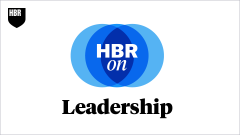If you’re a leader or aspire to be one, you’ve probably thought about how you project confidence and competence—or, what some call your executive presence. It’s as much a vibe you give off as it is a skill you can develop. And it’s important to exhibit if you want to assure others you’re ready to lead.
Megan Bock, the COO of an insurance technology company, has mastered executive presence. And Laura Sicola is a cognitive linguist who coaches executives. In this episode, Bock and Sciola discuss the key elements of executive presence and offer advice to a listener who’s trying to develop it while working remotely.
Key episode topics include: public speaking, leadership qualities, gender, personal growth, remote work, leadership
HBR On Leadership curates the best conversations and case studies with the world’s top business and management experts, to help you unlock the best in those around you. New episodes every week.
- Listen to the original Women at Work episode: The Essentials: Executive Presence
- Find more episodes of Women at Work
- Discover 100 years of Harvard Business Review articles, case studies, podcasts, and more at HBR.org
HANNAH BATES: Welcome to HBR on Leadership, case studies and conversations with the world’s top business and management experts, hand-selected to help you unlock the best in those around you.
If you’re a leader, or an aspiring one, you’ve probably thought about how you project confidence and competence—or, what some call your executive presence. It’s as much a vibe you give off as it is a skill you can develop. And it’s important to master if you want to assure others you’re ready to lead.
Today, you’ll hear from Megan Bock, the COO of an insurance technology company who’s mastered executive presence, and Laura Sicola, a cognitive linguist who coaches executives. They offer practical advice to a listener who’s trying to develop her executive presence while working remotely.
You’ll learn about the key elements of executive presence—like your ability to command a room, your communication style, and even your clothing choices. You’ll also learn how to use your voice and body language to project confidence, especially in virtual settings.
This episode originally aired on Women at Work in December 2019. Here it is.
AMY BERNSTEIN: You are listening to Women at Work from Harvard Business Review. I’m Amy Bernstein. Welcome to season four of The Essentials. This is a series in which Amy G. and I cover key career skills by bringing together experts in those skills with audience members who are looking to get better at them. The thing we like about grounding these episodes in the specifics of individual women’s experience is how it makes management principles less theoretical and practical advice more realistic, not only for that one woman participating in the conversation, but for all our listeners in all sorts of industries.
Here at HBR, I’m a vice president and I’m pretty confident that I come across as a leader, but a couple of jobs back – let’s say 15 years ago – I had an executive title, and yet according to my boss at the time, I didn’t act the part. In fact, she told me so. She said, “Amy, you need to work on your executive presence.” I was baffled. I had no idea what she was referring to. I ran back to my office and I Googled, “executive presence.” I realized what she was talking about. I was reticent. I rarely put myself forward, and I behaved as if I was waiting for someone to give me permission to step up. So, I had to be really stringent with myself and own that the feedback was pretty much on target and that was devastating. So, I started to view my world a little differently and I started to see opportunities that I would’ve shrunk from just a week earlier and forced myself to go for them. It might’ve been just speaking up in a meeting if I had something to add, at first timidly and then less timidly as I built up my confidence. I took on the scary stuff.
The big test for me was a board meeting, and the board was terrifying. They were the type of people, and there was one person in particular, who would slice you to ribbons if you didn’t know your stuff. So, I thought about what I could control. I could control the way I looked. What did I wear? I had a very nice suit with a nice silk blouse. I actually dressed really well for this job. The other thing I could control was my command of the material. So, I dug in. I had every fact, every figure. I had socialized a lot of it. I’d run it past people who knew more to get their feedback, and by the time I was doing the presentation, I could almost have done it with my eyes closed. When members of the board asked questions, I had answers, but I also had prepared myself for not having answers and then I could respond, “Good question. I’m going to have to find the answer and get back to you,” and I will still tell you that I think that I gave a solid B performance and that represented a victory to me. I had a lot more to learn. I had a lot more self-examination to do, but it changed the way I thought about my role, my path forward and my responsibility for my future.
Then I came to HBR and I encountered the ideas of Sylvia Anne Hewlett. Her thinking on executive presence is so clear. Sylvia’s an economist who runs a think tank and she has surveyed and interviewed a lot of business leaders. From that research, she’s identified the leadership traits that sets certain people apart. Those traits fall into three categories, gravitas, communication skills and appearance. Let me tell you about them. Gravitas consists of a bunch of elements, confidence, decisiveness, inclusiveness, respect for others, vision and integrity. Communication skills include the ability to command a room, to read an audience and to be authentic. Authenticity is also an element of the third category, appearance along with a polished look and a willingness to show up in person – even though appearance is, according to Sylvia, the least important factor.
That willingness-to-show-up-in-person piece is one that listener Mary Calmer is missing at the moment and she’s worried about it. Mary’s an insurance underwriter who wants to be an executive at some point in the future, and she’s trying to figure out how to make progress while working fully remotely at a company where she’s still pretty new.
MARY CALMER: One concern is that I’m just not visible enough and I don’t have as much face time as the people who are in the office every day and bumping into the CEO in the lunchroom and things like that.
AMY BERNSTEIN: She mostly communicates with colleagues and clients over email. Video calls are rare, and the few she does are generally one-on-one meetings with either her mentor or her boss.
MARY CALMER: I do a lot of work independently, to be honest. So, it’s hard to put myself out there, but that is one thing that I’ve been working on.
AMY BERNSTEIN: For motivation, she follows leaders like Megan Bock on LinkedIn.
MARY CALMER: I first heard Megan on a podcast for women in insurance called Bound & Determined, and I really resonated with her background. She started in a similar role as an underwriter, and she’s worked her way up to COO of her company, and she’s speaking on panels and traveling all around doing these great things, and I see her as a role model.
AMY BERNSTEIN: One who graciously agreed to join this conversation and leverage her industry expertise to advise Mary directly on how to grow and compete as a fully remote employee. Also with us is Laura Sicola, a cognitive linguist who coaches executives on how to communicate strategically. Megan and Laura’s advice isn’t just for Mary’s benefit though. It’s for yours too. Let me ask you, Megan, to what extent do you think executive presence contributed to your rise through the insurance industry and into tech?
MEGAN BOCK: I guess I would say executive presence is definitely a contributing factor. It is a part of, and perhaps even the impetus for continued promotion or opportunity, but table stakes is your subject matter expertise. You can’t actually have executive presence if you – this is just so obvious, but – if you don’t know what you’re talking about.
AMY BERNSTEIN: Right.
MEGAN BOCK: And so, I think that the growth trajectory for me was number one, becoming a deep expert. I was an underwriting leader, and so I needed to actually understand what the risk of loss was in any given account situation. For example, what’s the difference between the risk of loss to a general contractor versus a street and road contractor, and what’s the nuance if that general contractor works in Chicago or New York or South Florida versus Nevada or California or somewhere else? And I won’t bore you with the answers to those, but I can tell you that I know them. And so, first and foremost was understanding the subject matter. And then on top of that, the executive presence, the how you show up, the how you communicate helps your message be spread wider. And then executive presence doesn’t just happen naturally. I think you actually have to work at it.
AMY BERNSTEIN: So, let’s relate this to Mary, who is a senior commercial lines underwriter. When you were at that point in your career, say 10 or 12 years ago, did you have executive presence? Did you look the part of a senior leader?
MEGAN BOCK: I think unwittingly, yes. And here’s what I mean by that. I hate shopping. It is literally my nightmare. And so, in order to satisfy, sort of like, Well, I want to look nice, but I really don’t want to spend any time doing this, I found that Nordstrom has a free personal shopper service. And so, you can just go and tell them your size and they pull everything together to make you look fantastic, and as long as you put down your credit card and buy it, then it’s all done.
AMY BERNSTEIN: Right.
MEGAN BOCK: But I think the rest of it is first, the subject of matter knowledge. Second, I always prepare for a meeting. That means understanding what’s going on, understanding where I want the meeting to go, what my perspective is, and I come with a point of view.
AMY BERNSTEIN: So, then you must be projecting confidence.
MEGAN BOCK: Exactly. And you speak up with conviction. Being willing and comfortable to engage with people in the room regardless of their level in the hierarchy, I think is also important. And that’s one thing that I’ve seen trip other people up. If you’ve got a real senior leader, then perhaps you don’t feel prepared or want to speak up or ask a question, and it’s much better to go the opposite direction, still speak up, have an opinion. Worst case, it turns into a robust debate.
AMY BERNSTEIN: Mary, let me ask you how all that is landing with you? As you hear Megan describe how she prepares, also has worked on the finer points of executive presence, where are you hearing areas for development for yourself? Where are the gaps for you?
MARY CALMER: I think that makes a lot of sense. You have to be a rock star at your job before you can get promoted, and you have to prove yourself that you’re ready for that next step. Areas that I could work on, putting myself out there and working on public speaking, speaking with a more strong voice, I have a tendency to mumble sometimes. My husband says I tend to wear my emotions on my face, especially my negative ones. So, I definitely need to work on that as well.
AMY BERNSTEIN: Laura, you’re an expert in speech. So, what Mary just said must have raised a few thoughts for you?
LAURA SICOLA: Well, first, I think it’s important that we redefine the concept of public speaking because public speaking, at least from my perspective, is really anytime you’re talking to someone other than yourself, whether you’re having a one-on-one meeting, whether it is a formal presentation, it’s publicly sharing your ideas and trying to get buy-in, trying to understand the other person and establish that connection with them. So, what’s important I think, is that we are clear in our intentions and we let that intention drive our focus and drive our approach to that conversation or to that presentation. Is it something that needs a little bit of levity? Is it something that needs to show some passion, some conviction to it? Is it something that requires a little diplomacy? Whatever it is, starting with the intention, what is the result that we want to get? What’s the response? The mental, cognitive, the emotional, the behavioral? How do we want people to receive and respond to what we’re saying? Use that like a GPS coordinate. You punch that in as the destination and then calculate the route, so to speak. And I think that really helps to be more effective in having people hear both our content and our intent.
And when we think about the concept of more formal public speaking, as I think is probably what you were originally referring to, I think the easiest way to get past some of those nerves and get out of our own heads is what I like to call the four-words-secret to confident public speaking, which is simply, “it’s not about you.” If you’re public speaking, if you’re speaking to a one-on-one, to a group, to a meeting, to an audience, you are there because someone believes you have something to contribute. And it may be you who threw your hat in the ring because you believed you had something of value to give to that audience. So, they’re not waiting, leaning back in their chairs with folded arms to critique every little, “Um,” and, “Ah,” that you say. They’re just looking for the value. So, give it to them.
AMY BERNSTEIN: I laughed because I say that to myself all the time, Laura. Thank you for bringing that up.
MEGAN BOCK: I do want to come back and sorry if I’m going off script here for a moment, but I want to come back to something you said, Mary, in your original assessment of self, “I need to be a rockstar.” I actually don’t think you need to be a rockstar and hear me out. You have to have the competence. You have to know what you’re doing. You have to say what you’re going to do and do what you say. But I feel like it’s a little bit of diminishing returns to be a rockstar in a particular role because that takes quite a lot of energy. And I actually think that energy is better channeled into things like raising your hand for special projects or identifying ways to connect with others in your organization. As long as you’re competent and meeting expectations, you’ll be granted those types of opportunities. And it is those types of special projects that get you thinking about the business in a different way, get you connecting with others across the country in your organization, which gives you perspective that you wouldn’t have had, and a true ability to differentiate yourself as a leader because chances are in that special project, you are the one with the specific underwriting skillset. And so, what you say, which you might just consider baseline competence, is actually a big differentiator when applied in that kind of a setting.
AMY BERNSTEIN: I’m so glad you said that, Megan, because I think that women in particular tend to undermine themselves with this perfectionism, and I wonder if most of us are just a lot smarter than we think we are?
LAURA SICOLA: May I piggyback on that?
AMY BERNSTEIN: Of course, Laura.
LAURA SICOLA: About five minutes ago, I wrote down the word perfectionism and put a big X through it as I was listening to what you were describing. And to the point of, Do I raise my hand, do I volunteer, do I try to contribute? So many people – men and women, but women in particular – will be much less likely to speak up in a meeting if they don’t feel like they have the answer. That’s not what meetings are about. Meetings are about group collectively working through stuff because everybody has pieces to contribute to the puzzle. It’s co-construction of knowledge, co-construction of ideas. We don’t expect you to unilaterally fix it, but we do want to know that you have value to contribute to the process, to the team. Don’t hold that back from everybody else.
AMY BERNSTEIN: Mary, you have already taken steps in this direction.
MARY CALMER: So, I’ve been asked to help on a couple of working groups outside the scope of my job duties. One is kind of a project management. They’re implementing a new system and they want people from each division to give feedback on how this project is going to work, this platform that they’re rolling out. So, they want someone with an underwriting perspective.
AMY BERNSTEIN: And I wonder if you can now see ways that you can use that experience being part of this working group to develop your executive presence further?
MARY CALMER: It’s a lot to wrap my mind around, but yeah, I think there’s some opportunity there.
AMY BERNSTEIN: Megan, what would you advise her?
MEGAN BOCK: It’s a great question, and the way I would think about your engagement in that work would be as an underwriter advocate.
MA





